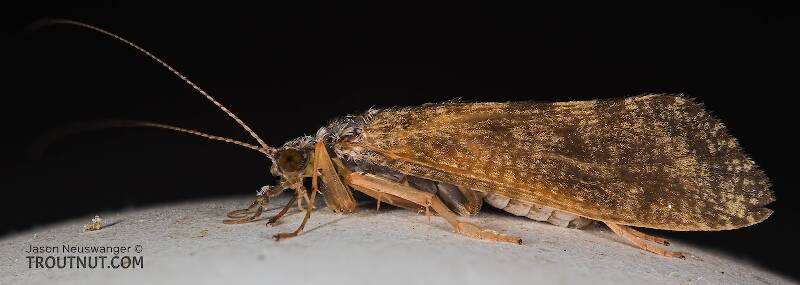
Blue-winged Olives
Baetis
Tiny Baetis mayflies are perhaps the most commonly encountered and imitated by anglers on all American trout streams due to their great abundance, widespread distribution, and trout-friendly emergence habits.


Mayfly Species Isonychia georgiae (Slate Drakes)
Species Range
Physical description
Most physical descriptions on Troutnut are direct or slightly edited quotes from the original scientific sources describing or updating the species, although there may be errors in copying them to this website. Such descriptions aren't always definitive, because species often turn out to be more variable than the original describers observed. In some cases, only a single specimen was described! However, they are useful starting points.
Male Spinner
Wing length: 10-12 mm
A reddish species with dark venation; fore tarsi purplish brown; tails distinctly ringed.
Head pale, with purplish red markings on carina, frontal margin and bases of antennae. Antenna reddish, pale at tip. Eyes purplish. Vertex red. Head of female yellowish, with a ruddy geminate median line and ruddy shading at the bases of the ocelli. A black line along the inner margin of the eye; corners of the occiput blackish. Thorax dark red; pleura somewhat paler. Anterior portion of mesonotum brighter red; scutellum, metanotum and sternum reddish black. Fore leg dark purplish brown, the femur paler at base and shaded with ruddy apically. Tarsus only slightly paler than the dark tibia, and equalling it in length. Middle and hind legs yellowish white; coxae red. Distal joint of tarsus, tarsal joinings and claws reddish brown. Wings hyaline. Veins of the costal border purplish brown, all others blackish.
Abdomen dark wine red, brighter ventrally; basal portions of segments somewhat translucent. Apical segments suffused with bright red. Segments 1 and 2 reddish black. Posterior margins of all segments widely black; a black line margins the pleural fold. No pale median line. Faint traces of dark submedian lines. Lateral dark lines well developed, between these and the pleural fold. Antero-lateral angles and backward extensions from these somewhat translucent on the middle tergites; on tergites 6-9 large yellowish white powdery patches suffused with red occupy these areas. Tergite 10 and sternites 6-9 are largely bright red. Tails brownish basally, suffused with purplish brown; whitish distally. All joinings widely dark purplish brown.
Genitalia dark reddish brown. The long second joint is about equal in length to the combined terminal joints. Forceps base only slightly excavated apically, almost concealing the penes. These are quite similar to Isonychia arida, but differ in finer details of structure (see fig. 125).
Described as I. thalia
Body length 12.5 mm, wing length 12 mm
A reddish brown species with dark venation.
Head greyish white; median carina red-purple. Black spot below lateral carina, on each side. Head of female yellow, the corners of the occiput dark purple. Notum yellow, borders light brown; mesonotal scutellum purplish. Pleural light brown with pale markings, washed with lavender anterior to wing roots. Reddish brown on sternum. Fore femur white at base, purple distally; tibia white at base, remainder greyish lavender; tarsus pale greyish lavender. Middle and hind legs whitish; claws and last tarsal joints pale smoky.
Tergites reddish brown. Median pale streak extends the length of the abdomen; pale also laterally, next to pleural fold. Pleural fold narrowly dark purple. Dark submedian and lateral streaks, somewhat interrupted, on each side. Ventrally rather purplish brown, with pale mid-ventral streak bordered by darker submedian streaks. Purple line parallels the pleural fold. In female, abdomen marked with purplish rose. Tails dull purplish brown, joinings somewhat darker. Penes of the male of the Isonychia arida type (see fig. 126).
Female Spinner
Wing length: 10-12 mm
Head of female yellowish, with a ruddy geminate median line and ruddy shading at the bases of the ocelli. Subanal plate of the female very shallowly excavated apically, its outer angles rounded.
Described as I. notata
Body length 13 mm, wing length 12 mm
A yellowish orange species with light purplish venation, known from the nymph and the female imago only.
Head (of female) greenish yellow; antenna purplish. A black spot below the lateral carina on each side, another below each eye. Dark purplish spots in corners of occiput and a narrow black line between the eye and the lateral ocellus. Thorax yellowish with a greenish tinge. Mesonotal scutellum lavender; pleura marked with lavender; metanotal scutellum purplish. A dark brown mark on each side of median line of metanotum. Sternum brown, purplish posteriorly; mesosternal spinous process dark brown; two dark transverse bars between the fore legs. Fore leg brown, the tarsus rather paler brown; femur and tibia washed with purple. Middle and hind legs greenish white; tarsus and distal fourth of tibia of middle leg, and last two tarsal joints of hind leg, dark olive brown. Wings hyaline, stigmatic area opaque whitish. Venation light purplish rose.
Abdomen yellowish orange dorsally, yellow ventrally. A wide pale median dorsal streak extends the length of the abdomen, margined by dark submedian streaks. Lateral dark streaks parallel the submedian streaks. Posterior margins of all segments dark purplish brown. Ventrally dark submedian streaks margin a pale median line. A purplish red line parallels the pleural fold posteriorly on each sternite; at its anterior end is a dark purple spot. Tails light purplish brown, paler distally; joinings conspicuously dark purplish brown. Subanal plate only slightly excavated at its apical margin, its outer angles rounded.
Described as I. thalia
Body length 12.5 mm, wing length 12 mm
Head of female yellow, the corners of the occiput dark purple. Subanal plate of the female very slightly excavated on its apical margin, its outer angles rounded.
Start a Discussion of Isonychia georgiae
References
- Needham, James G., Jay R. Traver, and Yin-Chi Hsu. 1935. The Biology of Mayflies. Comstock Publishing Company, Inc.
Mayfly Species Isonychia georgiae (Slate Drakes)
Species Range
Common Names
Resources
- NatureServe
- Integrated Taxonomic Information System
- Global Biodiversity Information Facility
- Described by McDunnough (1931)

